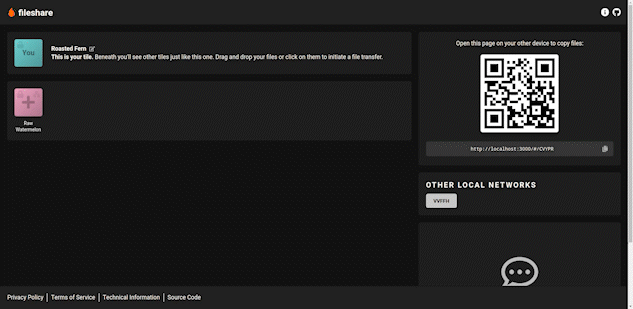Easy peer-to-peer file transfer.
Run yarn install, yarn build and then simply run yarn start to start the server.
The following variables are used in the build process:
| Variable | Default value | Description |
|---|---|---|
REACT_APP_TITLE |
filedrop |
Application title. |
REACT_APP_SERVER |
ws://[hostname]:5000/ws |
WebSockets server location. |
REACT_APP_USE_BROWSER_ROUTER |
0 |
1 if you want the application to use BrowserRouter instead of HashRouter. |
REACT_APP_ABUSE_EMAIL |
null | E-mail to show in the Abuse section. |
Run yarn install, yarn build and then simply run yarn start. For development you can also run filedrop-ws with live reload, yarn dev. You can also test the server with yarn test.
dotenv-flow is used to manage the configuration.
The following variables are used for the configuration:
| Variable | Default value | Description |
|---|---|---|
WS_HOST |
127.0.0.1 |
IP address to bind to. |
WS_PORT |
5000 |
Port to bind to. |
WS_BEHIND_PROXY |
no |
Set to yes if you want the application to respect the X-Forwarded-For header. |
WS_MAX_SIZE |
65536 |
The limit should accommodate preview images (100x100 thumbnails). |
STUN_SERVER |
stun:stun1.l.google.com:19302 |
STUN server address. |
TURN_MODE |
default |
default for static credentials, hmac for time-limited credentials. |
TURN_SERVER |
null | TURN server address. |
TURN_USERNAME |
null | TURN username. |
TURN_CREDENTIAL |
null | TURN credential (password). |
TURN_SECRET |
null | TURN secret (required for hmac). |
TURN_EXPIRY |
3600 |
TURN token expiration time (when in hmac mode), in seconds. |
NOTICE_TEXT |
null | Text of the notice to be displayed for all clients. |
NOTICE_URL |
null | URL the notice should link to. |
A docker-compose configuration is available in the docker-compose.yml file.
Installation can be achieved without Docker as well:
First you need to clone this project, build and run the server server and a TURN server (like coturn), read the README in filedrop-ws for more information on configuration.
Then you need to point the client to the WebSockets backend (fileshare-server) (in .env.local), build it and place it on some static file server (I use nginx for that). I also use nginx to proxy the back end through it. Here's a guide on how to achieve that.
I didn't feel comfortable logging into my e-mail account on devices I don't own just to download an attachment and cloud services have extremely long URLs that aren't really easy to type.
To the other device. Sometimes the (encrypted, since WebRTC uses encryption by default) data goes through the TURN server I run. It's immediately discarded after being relayed. File metadata also is not saved.
While ShareDrop and SnapDrop are both excellent projects and most definitely exist, I felt the need to create my own version for a several reasons:
- I wanted to build something using TypeScript.
- ShareDrop doesn't work when the devices are on different networks but still behind NAT.
- I didn't like the layout and design of both, I feel like the abstract design of FileDrop makes it easier to use.
- I was not aware of these projects while I started working on this project.
- ShareDrop's URLs are extremely long.
